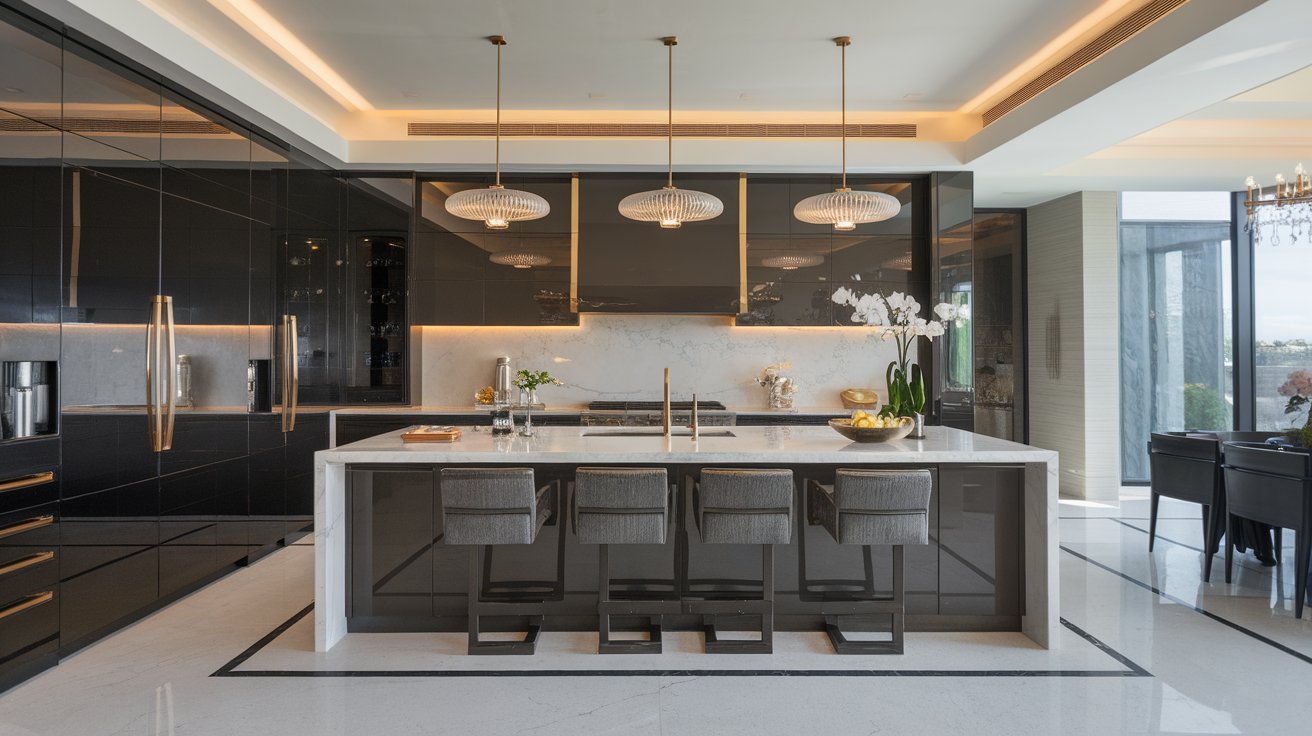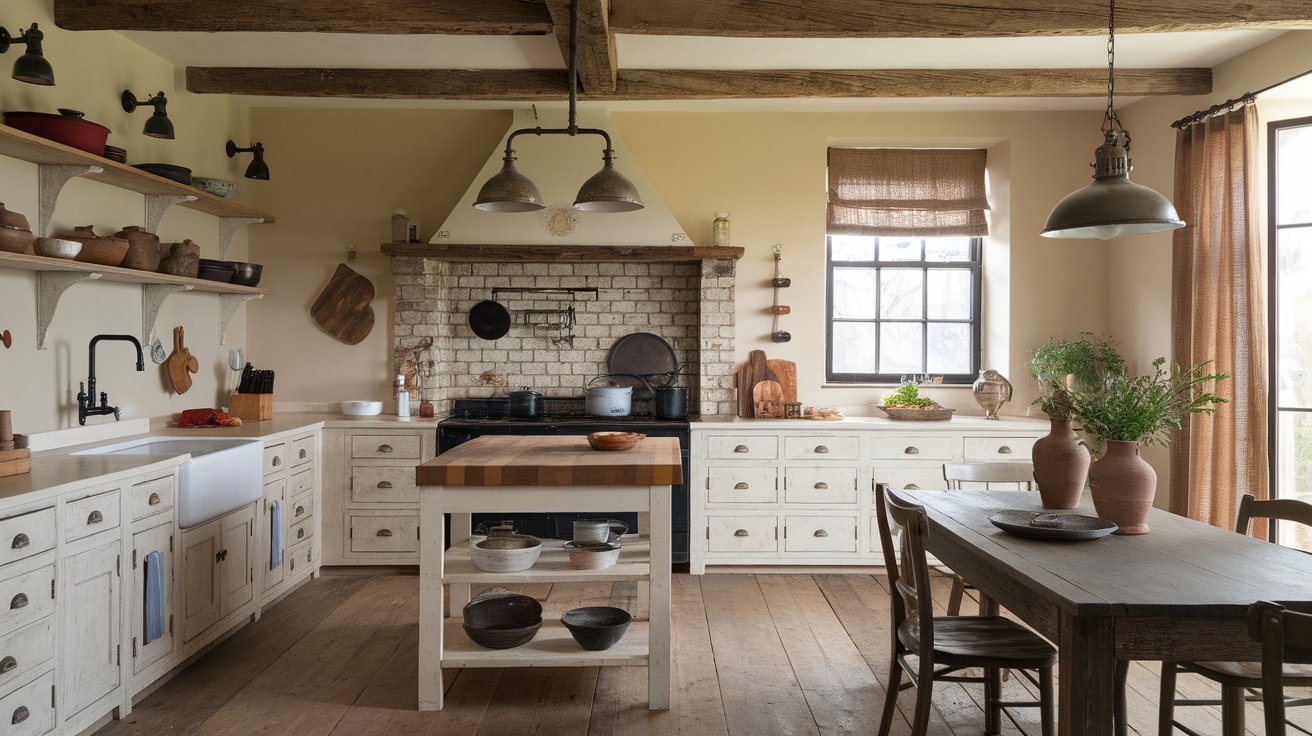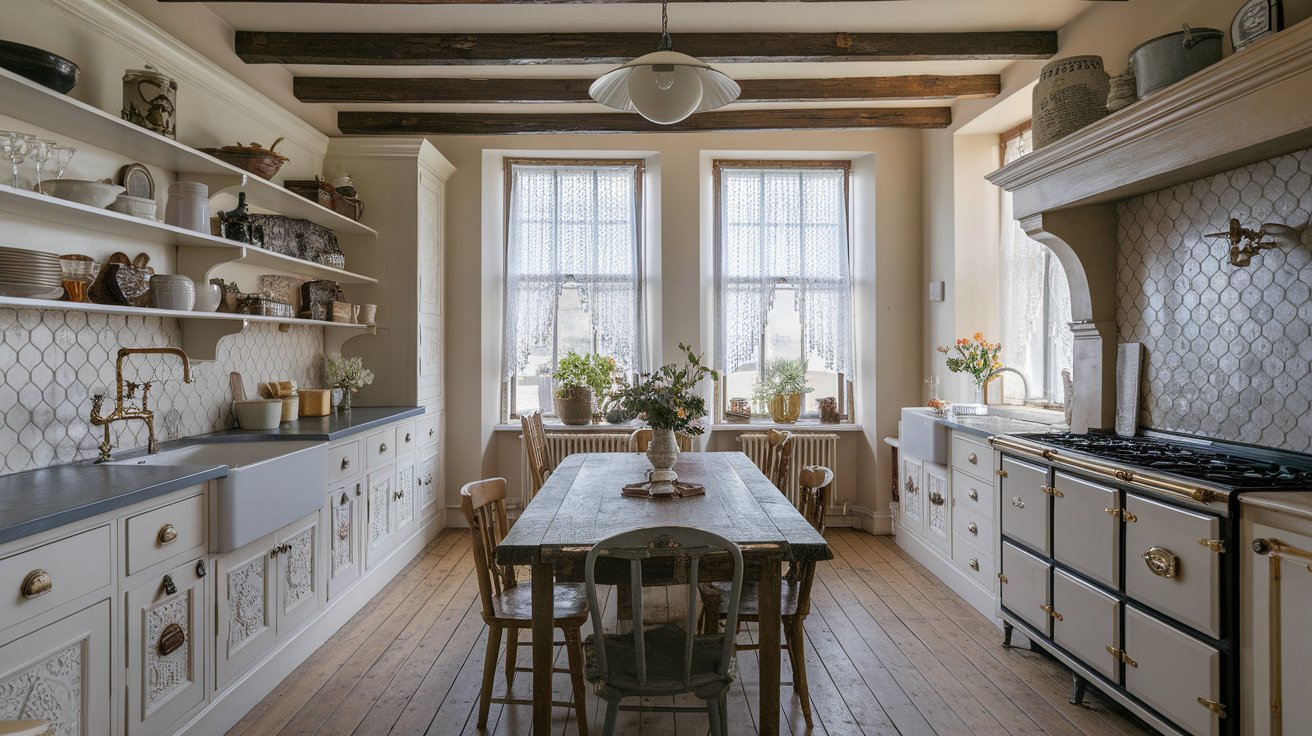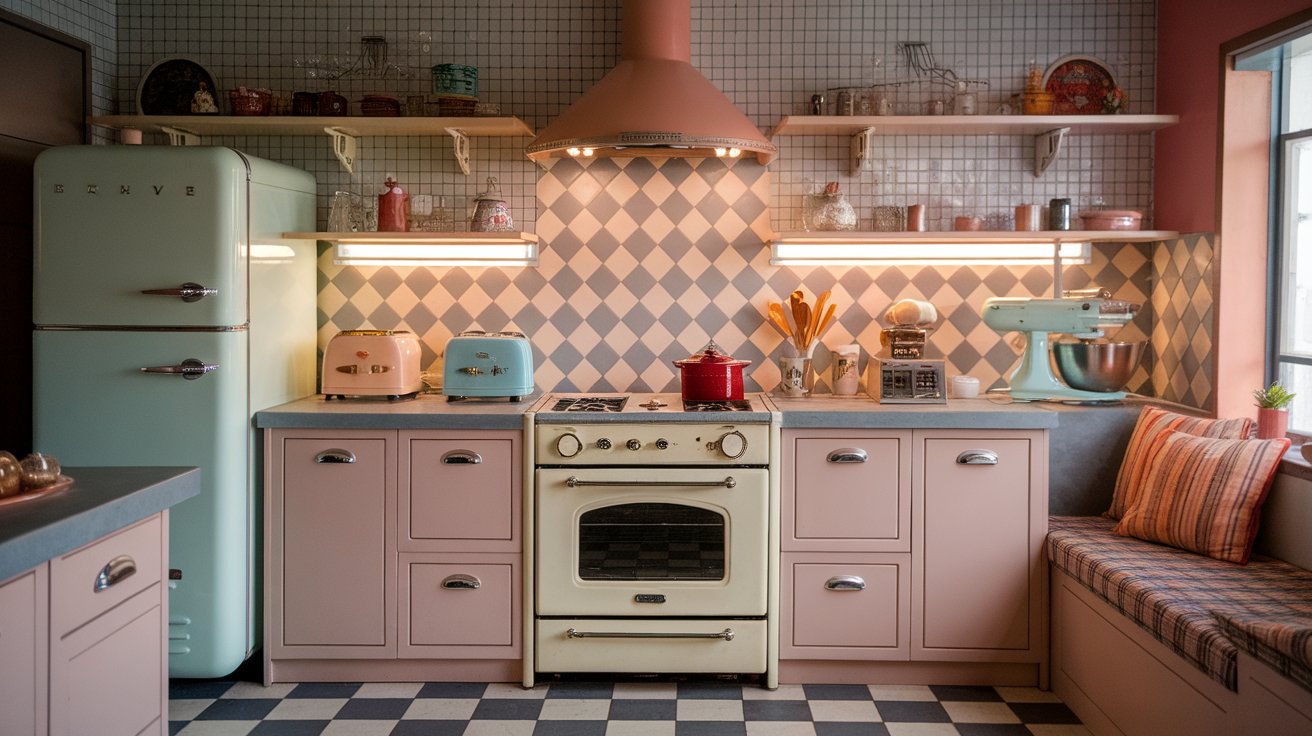Rustic European Kitchen Design Ideas
Rustic European kitchen designs beautifully blend warmth and simplicity with traditional craftsmanship. This style often showcases natural materials like wood and stone, creating a cozy atmosphere that feels both homey and timeless. Whether you’re looking for inspiration for a full renovation or just want to add a rustic touch, these kitchen design ideas bring a slice of European charm right into your home. Let’s explore some creative ways to capture that rustic vibe!
Open Shelving with Handcrafted Pottery

Rustic European kitchen design ideas often highlight open shelving as a key feature. This approach creates a warm and inviting atmosphere, showcasing beautifully crafted pottery.
The image captures a range of handcrafted pottery on wooden shelves. Each piece tells a story and adds character to the kitchen. From teapots to serving dishes, these items blend function and beauty.
Open shelving allows easy access to your favorite kitchenware. It encourages you to display your collection proudly while keeping essentials within reach. Incorporating rustic elements, like worn wooden shelves, enhances the charm of your space.
Consider mixing different styles of pottery for a unique look. Combining colors and textures creates visual interest, making your kitchen both practical and stylish. This blend is essential in achieving authentic rustic European kitchen design ideas.
Don’t forget to arrange items by height and size for an aesthetically pleasing display. Remember, the goal is to make your kitchen feel lived-in and welcoming.
Timeless Shaker-Style Cabinets
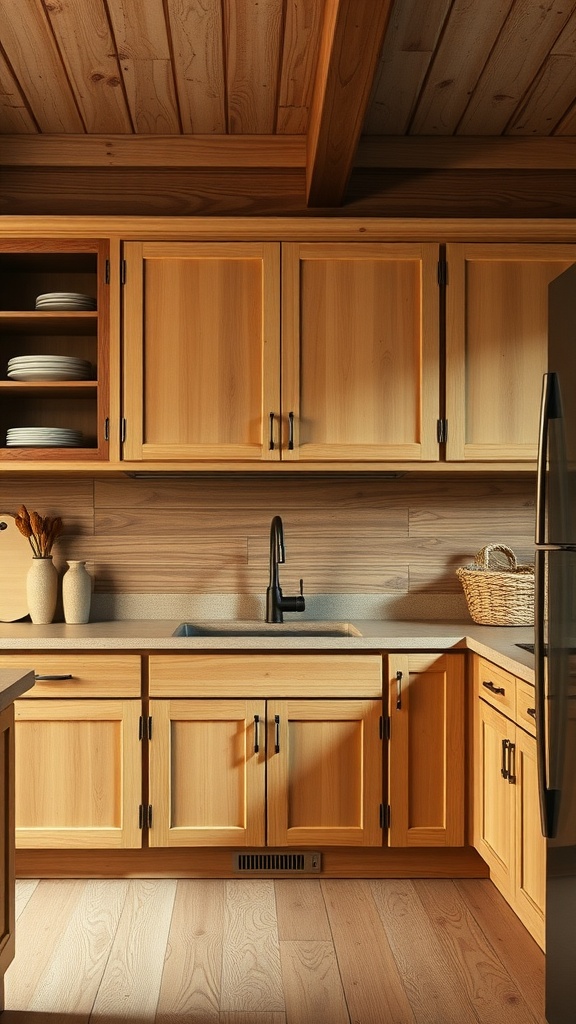
Shaker-style cabinets are a staple in rustic European kitchen design ideas. Their clean lines and simple elegance make them a perfect choice for any kitchen. The image showcases beautiful wooden cabinets that radiate warmth and charm.
The rich wood tones and smooth finish highlight the natural beauty of the materials. These cabinets not only offer ample storage but also contribute to the overall rustic feel of the kitchen. The open shelving adds a touch of openness, allowing you to display your favorite dishes or decor.
Incorporating shaker-style cabinets into your rustic European kitchen design ideas can create a cozy and inviting atmosphere. Pair them with a farmhouse sink and rustic accessories for a truly timeless look. The functionality of these cabinets makes them a practical choice, while their design keeps them stylish and relevant.
Consider using natural finishes that enhance the wood’s grain. This will keep your kitchen feeling warm and connected to nature. Incorporating shaker-style elements can transform your space into a rustic haven, blending beauty with practicality.
Stone Accent Walls for Natural Texture
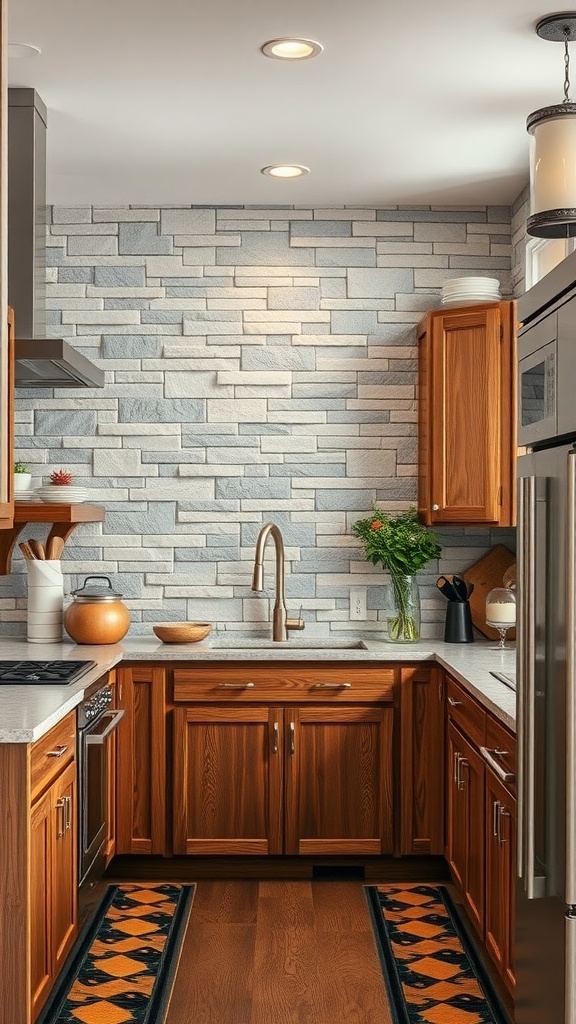
Stone accent walls bring a cozy, rustic vibe to any kitchen. They add depth and character, making your kitchen feel warm and inviting. In this kitchen, the stone wall beautifully contrasts with the wooden cabinets, enhancing the rustic European kitchen design ideas.
The mix of light and dark stones creates visual interest. This texture not only looks great but also feels natural. You can almost imagine gathering with friends and family in a space like this. It’s perfect for cooking or just enjoying a cup of coffee.
Incorporating stone into your kitchen design can be simple. You can choose from many styles and colors to fit your taste. The right stone can make your kitchen stand out, reflecting classic European charm. Think about the options available to achieve that rustic European kitchen design.
Lighting plays a vital role too. Here, the recessed lights highlight the stone wall, making it a focal point. This lighting choice enhances the overall design while keeping the space functional. Consider how lighting can elevate your rustic European kitchen design ideas.
Don’t forget about accessories! The earthy tones of the stone wall pair well with wooden or ceramic items. Simple touches like a vase of fresh flowers can make the space feel alive. This kitchen demonstrates how small details contribute to the rustic European kitchen design.
Whether you go for full stone walls or just a few accents, the impact is undeniable. Stone makes your kitchen feel grounded while allowing for a stylish look. This combination is key in rustic European kitchen design ideas.
Warm Earthy Color Palettes
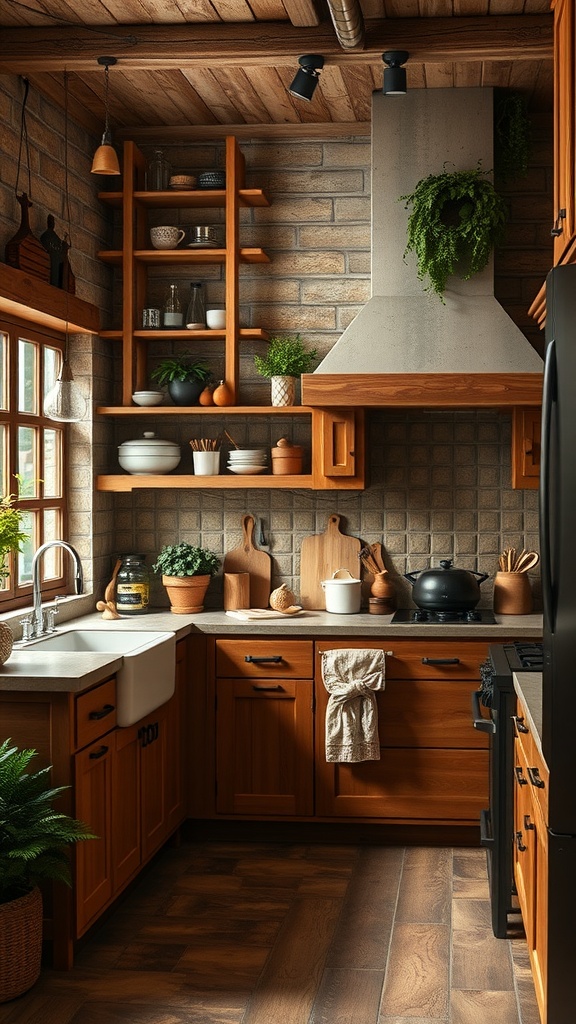
Rustic European kitchen design ideas often highlight warm earthy color palettes that create a cozy atmosphere. The image showcases a kitchen with rich wooden cabinets and a stunning stone wall. These elements work together to create a warm, inviting space.
Notice the use of natural materials, like wood and stone, which are essential in rustic designs. The warm tones in the cabinetry and the floor add a sense of comfort that is hard to resist. The colors mimic the natural world, making the kitchen feel like a peaceful retreat.
Incorporating plants and herbs, as seen in the image, brings life and freshness to the kitchen. This not only enhances the rustic vibe but also contributes to a healthy cooking environment. The addition of terracotta pots and wooden utensils adds character, reinforcing the earthy palette.
When considering rustic European kitchen design ideas, think about how these warm colors make you feel. They evoke feelings of home, warmth, and simplicity. The gentle blend of browns, greens, and soft whites creates a harmonious look that is both functional and beautiful.
Whether you’re renovating or just dreaming, look to these warm earthy color palettes to inspire your rustic European kitchen. They truly make a space feel inviting and alive, perfect for gathering with family and friends.
Rustic Dining Table Made from Reclaimed Wood
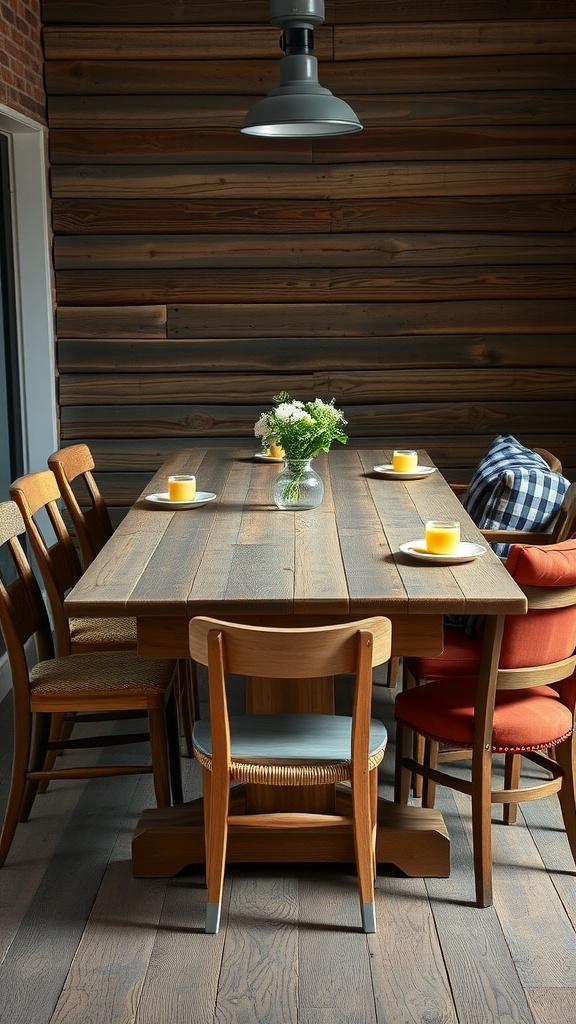
When thinking about rustic European kitchen design ideas, a reclaimed wood dining table is often at the top of the list. This type of table brings warmth and character to any space. It not only stands out but also feels inviting and cozy.
In the image, the dining table showcases beautiful natural grains and imperfections that tell a story. The rich tones of the wood contrast nicely with the soft lighting above, creating a welcoming atmosphere. The simple centerpiece of flowers adds a touch of freshness, making the table ready for a meal or a chat with friends.
The mix of chairs around the table adds to the charm. Each chair has its unique style, yet they come together harmoniously. This mix mirrors the essence of rustic European kitchen design ideas, where variety is celebrated.
Rustic dining tables like this one encourage gatherings. They invite laughter, shared meals, and deep conversations. The sturdy construction of reclaimed wood guarantees that this table will last for generations. It’s not just a piece of furniture; it’s a piece of history.
If you’re considering a rustic theme for your kitchen, a reclaimed wood dining table can be an excellent starting point. It sets the tone for the entire space. Think about complementing it with other rustic elements like vintage tableware and natural fabrics. With a little creativity, you can make your kitchen a reflection of rustic charm.
Exposed Wooden Beams and Rustic Charm
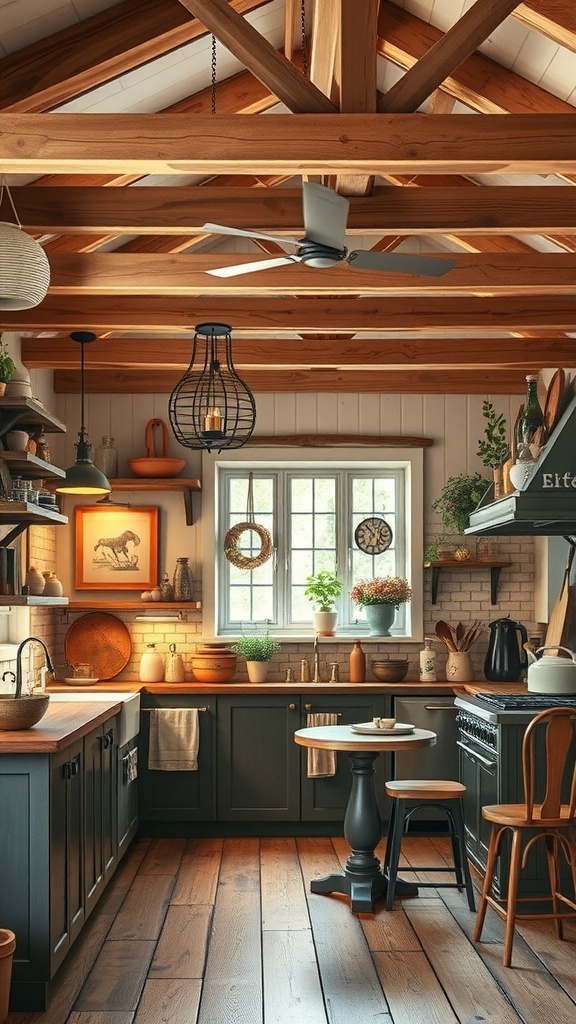
Rustic European kitchen design ideas often highlight the beauty of exposed wooden beams. These beams add character and warmth to the space. They create a cozy atmosphere, making the kitchen feel welcoming and homey.
The image showcases a kitchen that embodies this rustic charm perfectly. The wooden beams not only support the ceiling but also draw the eye upward, enhancing the room’s height and openness. This design choice reflects traditional European styles that prioritize both functionality and aesthetics.
Incorporating rustic elements like wooden beams in your kitchen can transform the space. It allows for versatility in decor, blending modern appliances with classic design. This fusion creates a unique environment that feels rooted in history while still being comfortable for everyday use.
Choosing a color palette that complements the wooden tones is essential. Dark cabinetry, like in the image, contrasts beautifully with the light beams. This balance enhances the rustic feel, making the kitchen an inviting space for cooking and gathering with loved ones.
Another key aspect of rustic European kitchen design ideas is the use of natural materials. Pairing wooden beams with stone or brick accents brings an earthy vibe that connects the kitchen to nature. It’s a reminder of simpler times, making the cooking experience more enjoyable.
To achieve this look in your kitchen, consider open shelving to display dishware and decorative items. This not only adds to the rustic charm but also makes everything easily accessible. The image illustrates how thoughtful placements of decor can elevate the overall design.
Remember, when embracing rustic European kitchen design ideas, it’s all about creating a warm and inviting space. Exposed wooden beams play a significant role in achieving that rustic charm. They invite you to slow down and enjoy the simple pleasures of cooking and gathering.
Charming Vintage Appliances
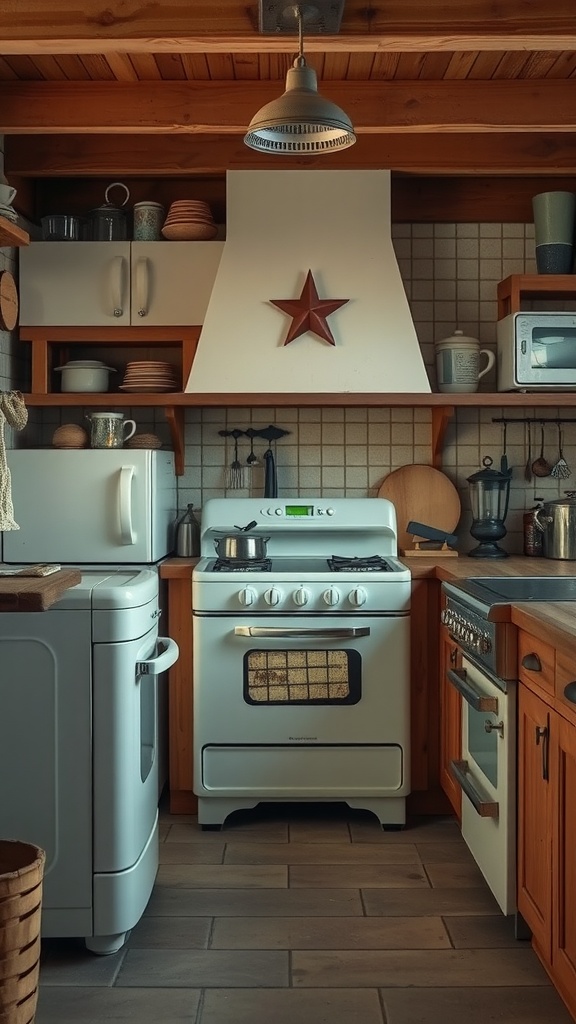
In rustic European kitchen design ideas, charming vintage appliances take center stage. These pieces not only serve their practical purpose but also add character to the space. Imagine stepping into a kitchen where a lovely white stove stands proudly, offering a hint of nostalgia with its classic design.
The pop of color from the star hanging above the stove really draws the eye. It creates a welcoming vibe that invites family and friends to gather around. You can almost hear the laughter and chatter as meals are prepared in such a cozy setting.
A vintage fridge, with its rounded edges and retro style, complements the kitchen beautifully. It’s perfect for storing fresh ingredients needed for those delightful rustic recipes. The wooden shelves hold handmade dishes and cozy mugs, making everything feel homey and warm.
Rustic European kitchen design ideas shine with these vintage appliances, as they blend function and style seamlessly. The combination of wood and subtle colors adds to the charm, making this kitchen a perfect spot for culinary creativity.
Every detail counts in creating a warm, inviting atmosphere. A charming vintage appliance can be the centerpiece that ties the entire kitchen together. If you’re looking to upgrade your space, consider how these elements can bring a touch of history and warmth to your home.
Farmhouse Sink with Vintage Fixtures
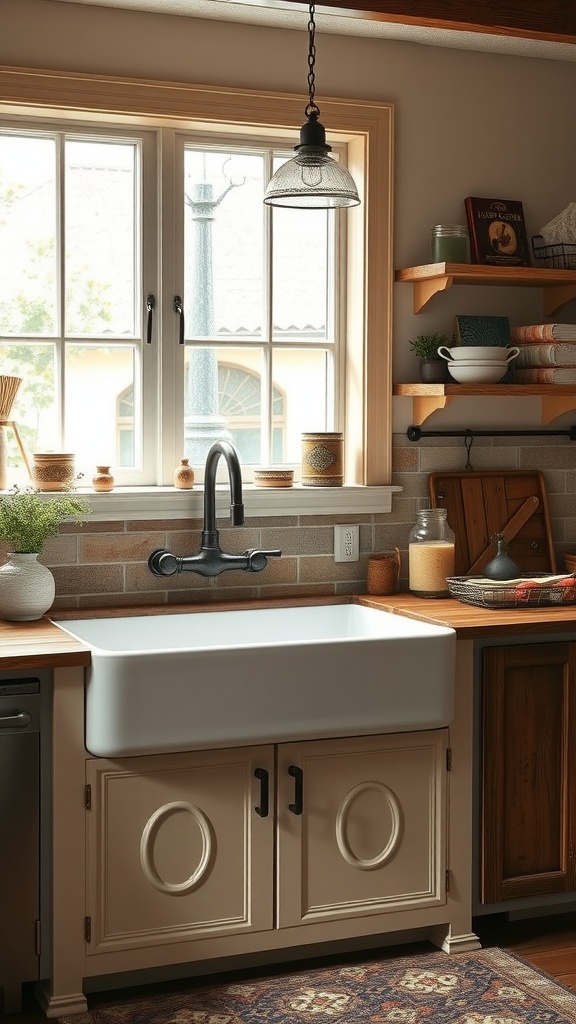
A farmhouse sink is a classic choice for any rustic European kitchen design. Its large basin offers practicality, making it perfect for washing dishes or preparing meals. The vintage fixtures add a charming touch, enhancing the overall aesthetic of the kitchen.
The sink’s simplicity blends beautifully with the warm wood counters and earthy tones in the cabinetry. This combination creates a cozy atmosphere, inviting families to gather and enjoy home-cooked meals.
Rustic European kitchen design ideas often include open shelving, which allows for easy access to everyday items. The shelves in this kitchen display lovely pottery and plants, adding life and personality to the space.
Natural light pours in through the window, making the space feel airy and bright. This is essential in any kitchen, especially one designed with rustic elements. The soft glow highlights the textures of the wood and stone, showcasing the charm of this farmhouse style.
Incorporating a farmhouse sink with vintage fixtures is a smart choice for those looking to achieve a rustic European kitchen design. This design prioritizes functionality while still feeling warm and welcoming.
A Welcoming Hearth and Fireplace
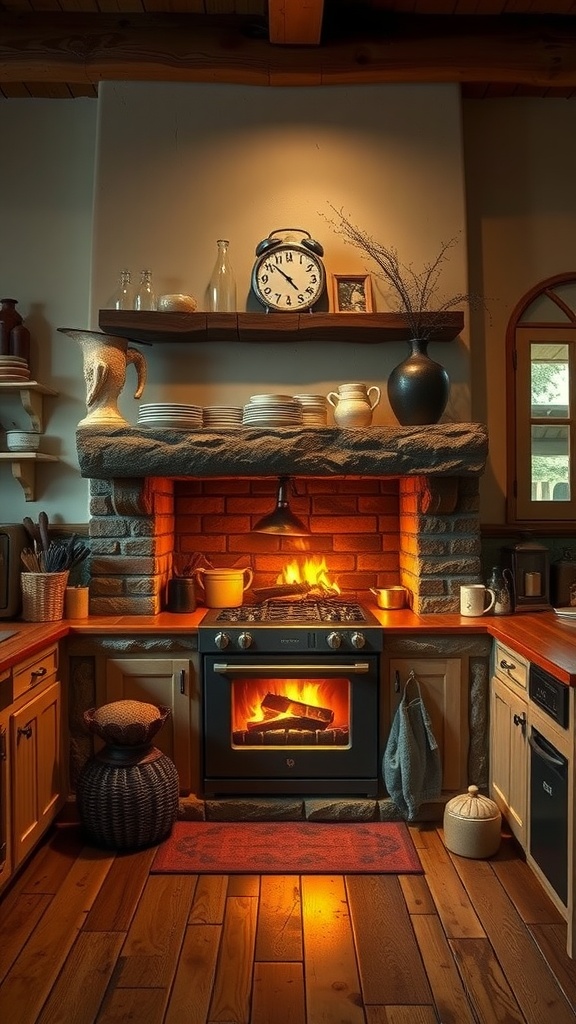
A rustic European kitchen design often centers around a cozy hearth. This image shows a beautifully crafted fireplace that instantly draws you into the space. It creates a warm and inviting atmosphere, perfect for gatherings with family and friends.
The stonework around the fireplace adds character and traditional charm. It’s a great example of how a rustic European kitchen design idea can bring a touch of the countryside into your home. The flames dancing in the fireplace provide both warmth and a sense of comfort.
The arrangement of the kitchen around the fireplace encourages a communal feel, making it a perfect spot for cooking and sharing meals. This design idea highlights the importance of a hearth in creating a welcoming environment.
The wooden flooring and natural textures complement the fireplace, enhancing the rustic charm. A well-placed clock and various decorative items on the shelf above the fireplace add a personal touch, making the space feel lived in.
Incorporating a fireplace into your kitchen not only serves a practical purpose but also adds aesthetic value. It’s an essential element in many rustic European kitchen design ideas, ensuring that the heart of the home remains warm and inviting.
Mixed Materials for an Eclectic Look
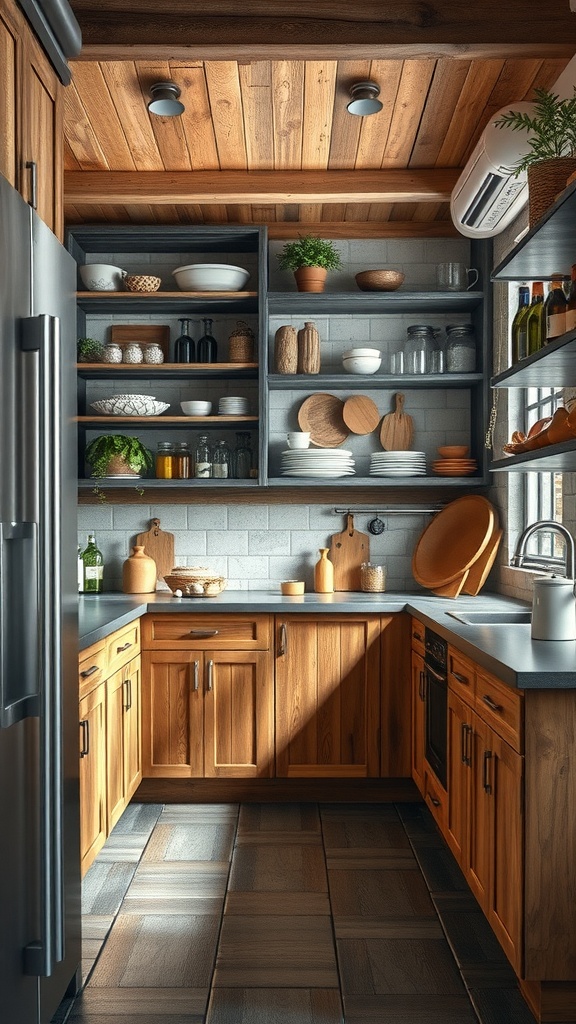
In this rustic European kitchen, mixed materials create a warm and inviting atmosphere. The wooden cabinets and ceiling beams add natural charm, while the contrasting gray shelves bring a modern touch. This blend is perfect for those inspired by rustic European kitchen design ideas.
The combination of textures is key here. The smooth countertop complements the roughness of the wooden elements, creating a balanced look. You’ll notice how ceramics and glassware are displayed on open shelves. This not only adds character but also makes everyday items part of the decor.
Lighting plays a significant role too. The subtle lights highlight the wooden accents, enhancing the rustic feel. If you’re considering rustic European kitchen design ideas, think about how you can mix materials in a way that feels cohesive yet eclectic.
Plants on the shelves introduce a bit of greenery, connecting the kitchen to nature. This is another great tip for adding personality to your kitchen space while still adhering to the principles of rustic design. Incorporating various textures and materials can truly bring your kitchen to life.
Rustic Lighting Fixtures with Character
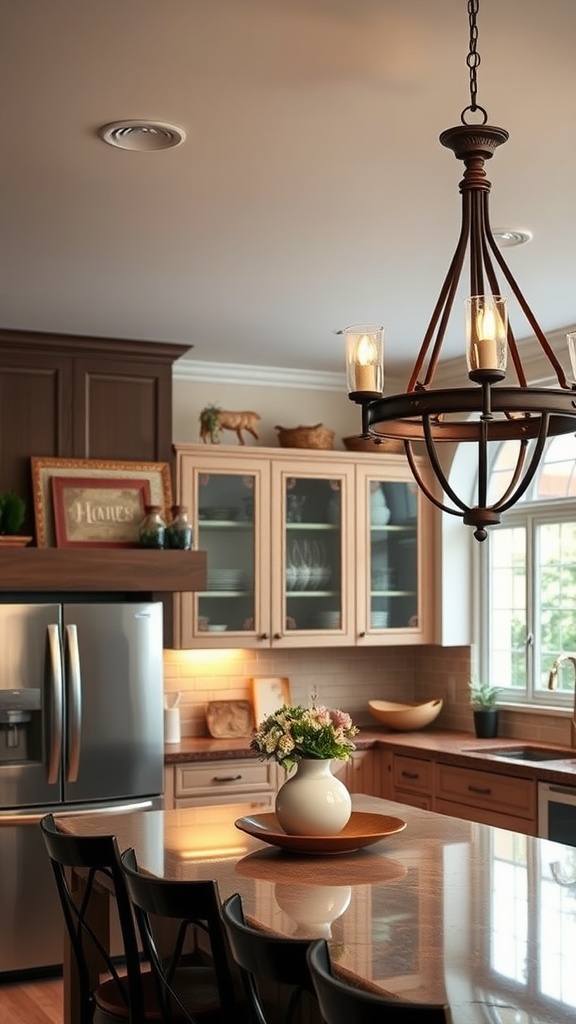
The image showcases a charming rustic kitchen that beautifully highlights the importance of lighting in a home. The centerpiece is a stunning chandelier that combines both style and warmth. This fixture adds character, making it a key element in rustic European kitchen design ideas.
The chandelier features soft, glowing lights which create a welcoming atmosphere. It hangs gracefully above a well-crafted kitchen island, inviting family and friends to gather around. The wooden tones of the chandelier complement the cabinetry, enhancing the rustic vibe.
Surrounding the chandelier, we see a well-designed kitchen space with natural materials and earthy colors. The open shelving displays handcrafted items and decorative pieces, reinforcing the rustic theme. It’s these details that truly bring rustic European kitchen design ideas to life.
Lighting fixtures like this chandelier serve more than just function; they become focal points that elevate the overall design. When considering rustic European kitchen design ideas, think about how lighting can enhance the space, creating warmth and charm.
Combining various lighting options is also a great way to add depth. Task lighting under cabinets can work alongside a beautiful chandelier to ensure the kitchen feels cozy and practical. Explore how different fixtures can highlight the beauty of your rustic kitchen.
Farmhouse-Style Breakfast Nook
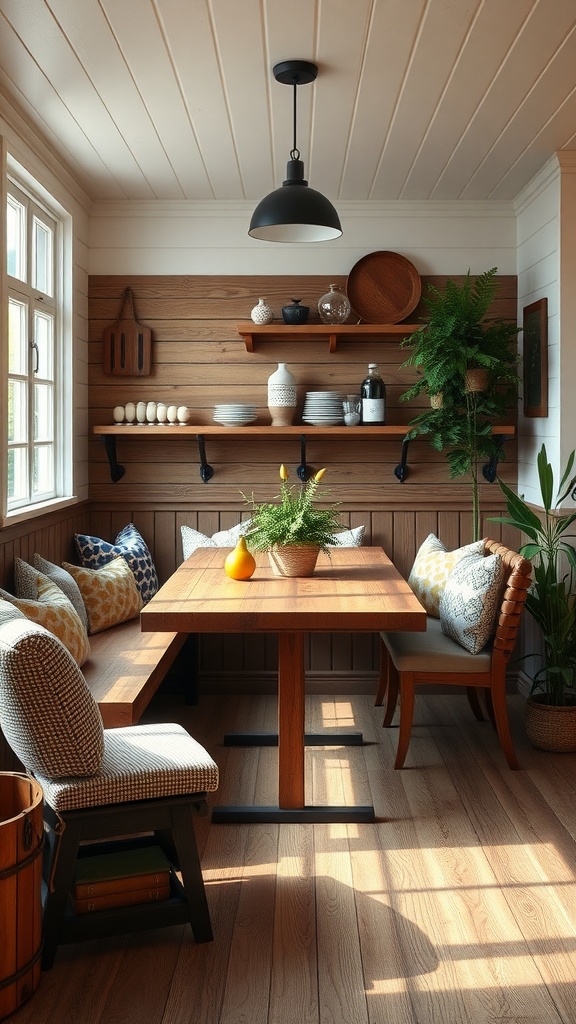
The farmhouse-style breakfast nook is a delightful addition to any rustic European kitchen design. Picture a cozy table surrounded by inviting seating, perfect for family meals or morning coffee. The warm wood tones and natural elements create a welcoming vibe that draws people in.
This nook features a sturdy wooden table, paired with charming chairs that encourage relaxation. The mix of patterns on the cushions adds a playful touch, making it a great spot to linger over breakfast. The carefully chosen decor, like the plants and simple tableware, enhances the rustic atmosphere.
Natural light floods in through the windows, illuminating the space and bringing life to the rustic European kitchen design ideas. Set against a backdrop of wooden panels and open shelving, the nook feels both practical and stylish. It’s a beautiful blend of function and charm.
For those seeking rustic European kitchen design ideas, this nook serves as an inspiring example. It seamlessly combines comfort and style, making it an ideal place for gatherings. Whether it’s a leisurely brunch or a quick bite, the farmhouse-style breakfast nook is sure to become a beloved spot in any home.
Herb Gardens on Window Sills
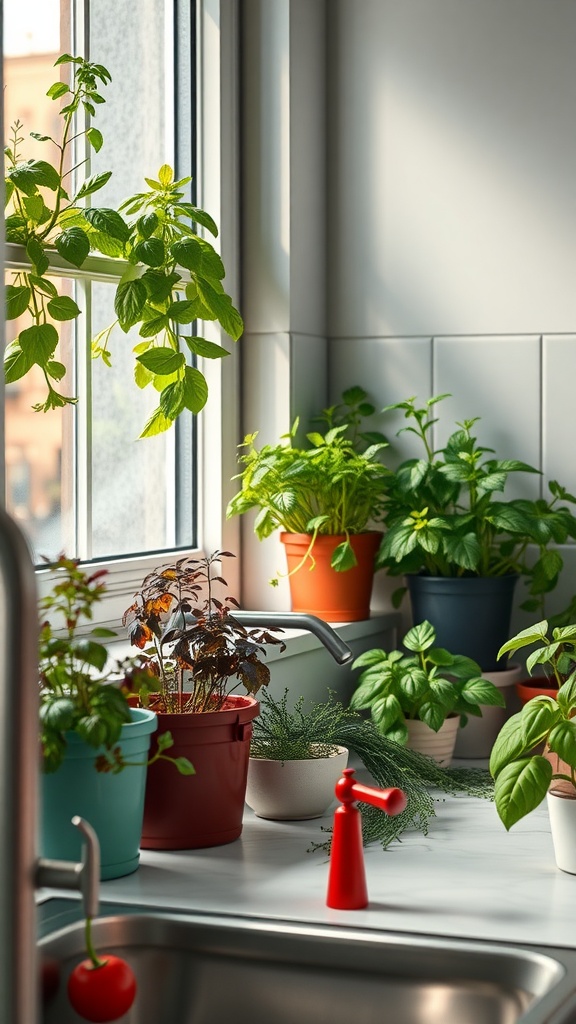
When designing a rustic European kitchen, adding an herb garden on the window sill is a fantastic idea. Not only does it bring a touch of nature indoors, but it also enhances the kitchen’s charm and functionality.
The image showcases various herbs in colorful pots, soaking up the sunlight. This vibrant display adds life to the kitchen space, making it feel warm and inviting. Herbs like basil, mint, and rosemary are perfect for this purpose, offering fresh aromas and flavors.
Incorporating herb gardens into rustic European kitchen design ideas is simple. Choose pots that match the rustic theme, like terracotta or wooden containers. Position them where they can receive ample sunlight, typically near the window. Regular watering and pruning will keep the herbs thriving.
Besides their aesthetic appeal, having fresh herbs at your fingertips is a culinary delight. They can elevate your dishes, making everyday meals feel special. Imagine snipping off fresh basil for a pasta dish or mint for a refreshing drink!
Using herbs can also promote a healthier lifestyle. You can grow organic herbs right at home, avoiding any pesticides that might be found in store-bought alternatives. This aligns perfectly with the natural and rustic feel of European kitchens.
In summary, an herb garden on window sills is an excellent addition to rustic European kitchen design ideas. It not only enhances the beauty and charm of the kitchen but also provides fresh ingredients for cooking.
Floral Patterns and Textiles
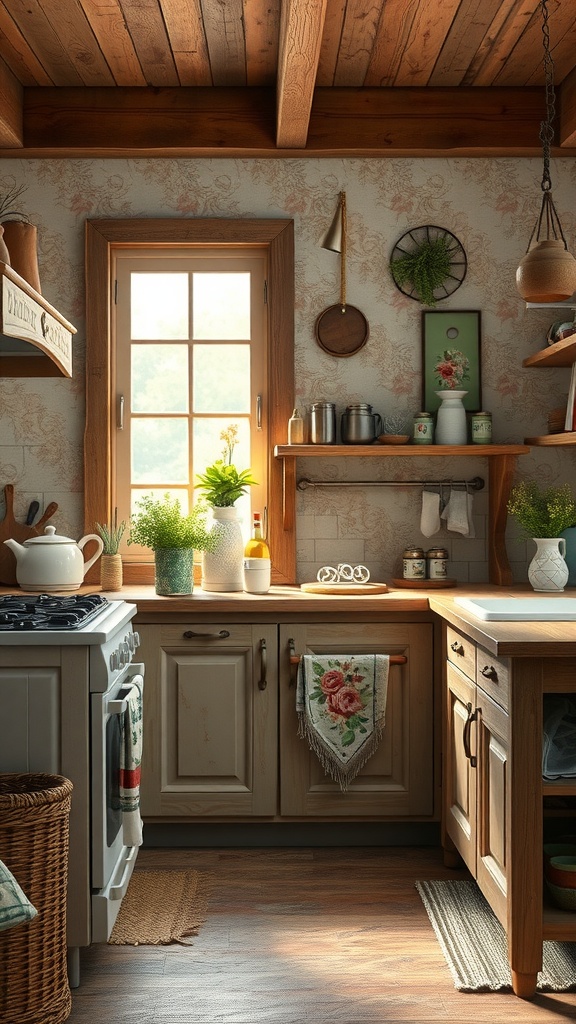
In a rustic European kitchen, floral patterns add a touch of charm and warmth. The image showcases a lovely space filled with natural light. The walls are adorned with delicate floral wallpaper, creating a cozy atmosphere.
The textiles used, like the dish towels featuring vibrant roses, tie the whole look together. They complement the wooden cabinets and countertops, emphasizing a connection to nature. Textiles play a key role in Rustic European Kitchen Design Ideas, bringing in colors and textures that make the space feel inviting.
Open shelves display potted plants and kitchen essentials, enhancing the natural vibe. Items are arranged to highlight simplicity and functionality, which is a hallmark of rustic design. The balance of functionality and aesthetic appeal is what makes these kitchens so beloved.
Ultimately, floral patterns and textiles breathe life into a rustic kitchen. They create a unique look that is both homey and stylish. If you’re considering Rustic European Kitchen Design Ideas, don’t shy away from incorporating these delightful elements into your own space.
Functional Yet Stylish Kitchen Islands
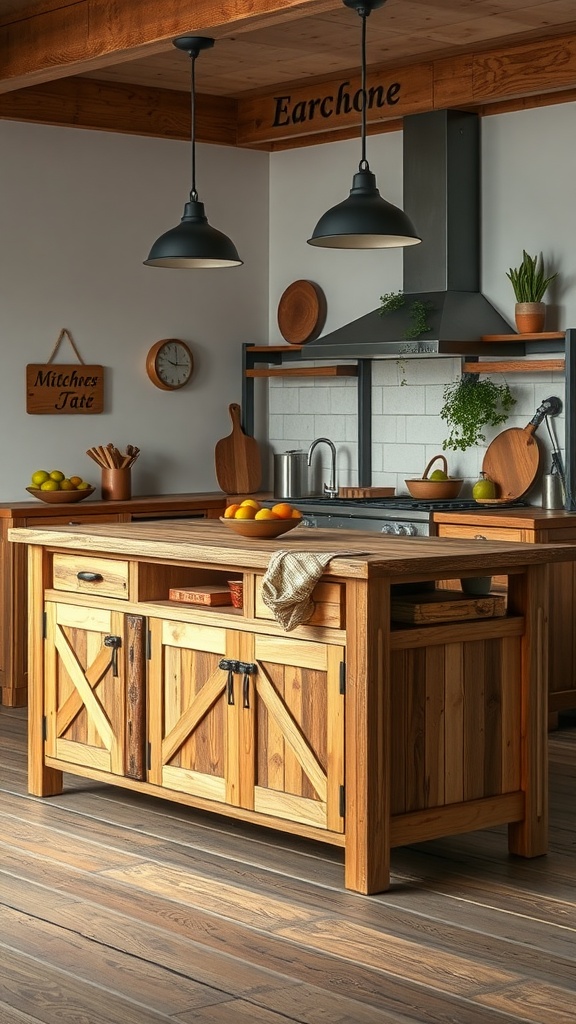
In the heart of any Rustic European kitchen, the kitchen island serves as both a functional space and a stylish focal point. This image beautifully showcases a wooden kitchen island that embodies the essence of rustic design. The warm tones of the wood create a welcoming vibe, making it an ideal spot for family gatherings or casual meals.
Notice the thoughtful arrangement of items on the island. Fresh fruits add color and a touch of nature, while the clean lines and sturdy construction highlight its practicality. This kitchen island is not just for show; it provides ample space for food preparation and serves as a casual dining area.
The design integrates functionality without sacrificing style. The sliding doors and drawers offer convenient storage solutions, perfect for keeping essentials close at hand. A rustic kitchen island like this can easily become the heart of your culinary activities.
Incorporating a kitchen island into your Rustic European kitchen design can elevate the overall aesthetic while ensuring that your space remains practical. Whether you’re cooking, entertaining, or just enjoying a cup of coffee, a well-designed kitchen island makes everything easier and more enjoyable.
Antique Accessories and Decor
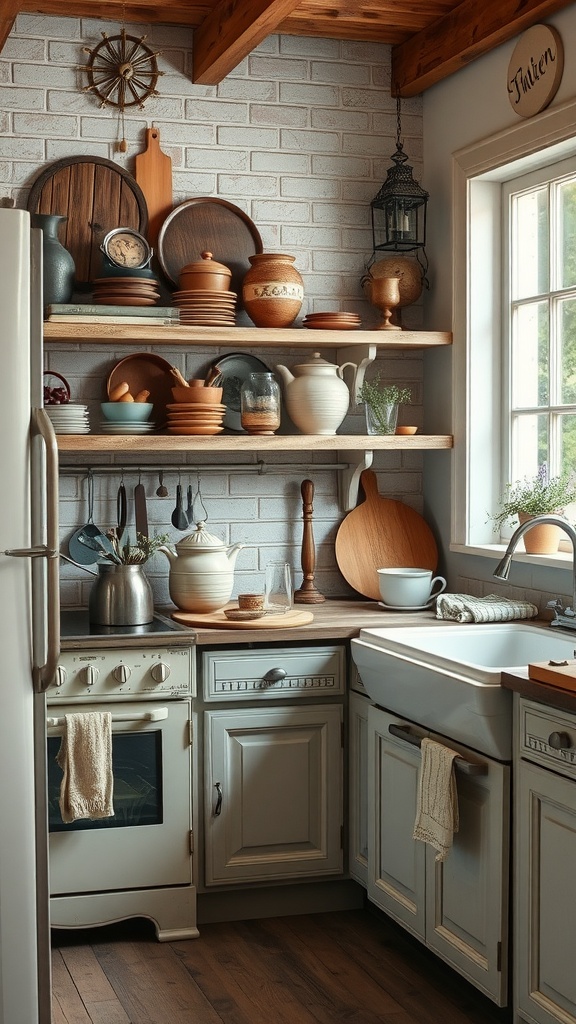
Adding antique accessories to your kitchen can create a cozy atmosphere. In the image, you can see a charming display of vintage items that enhance the rustic vibe. Items like wooden bowls, old-fashioned teapots, and ceramic jars contribute to the overall warmth.
One standout feature is the collection of plates and dishes on the shelves. They showcase different textures and finishes, adding character and history. This arrangement not only serves a practical purpose but also acts as decor, making your kitchen feel lived-in and loved.
The wooden accents seen in the kitchen, such as the beams and shelves, beautifully complement the antique pieces. These details tie together the rustic European kitchen design ideas, emphasizing a connection to nature and craftsmanship.
Utilizing these antique accessories can inspire a sense of nostalgia. Each piece tells a story and connects to the rich tradition of European kitchens. Whether it’s a vintage clock or a handcrafted cutting board, these items add charm to your cooking space.
For those looking to implement rustic European kitchen design ideas, consider incorporating similar antique elements. They can transform a modern space into a timeless kitchen that feels inviting and functional.
Natural Light Through Large Windows
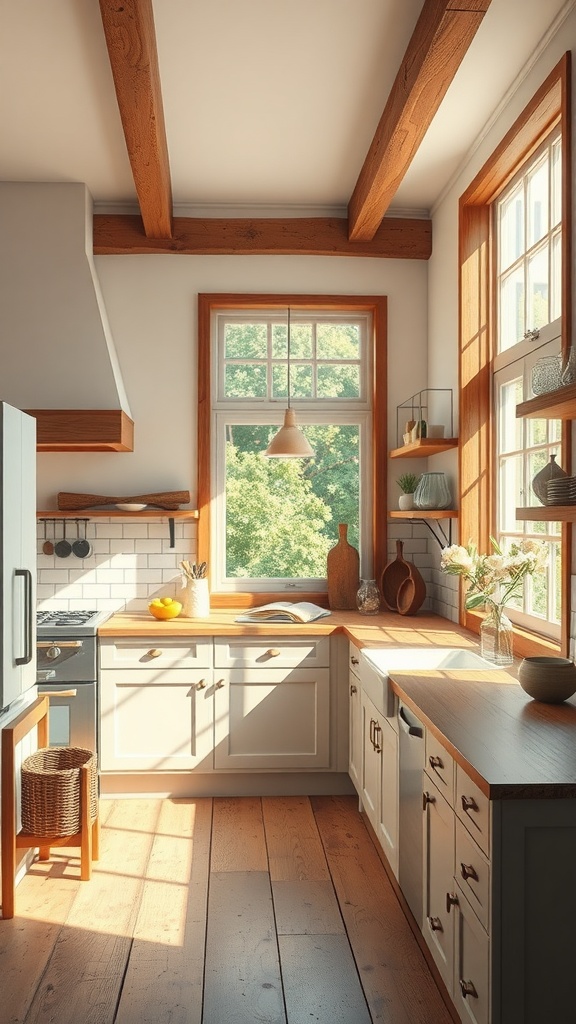
Natural light plays a significant role in Rustic European Kitchen Design Ideas. The large windows in this kitchen flood the space with sunlight, creating a warm and inviting atmosphere. This design choice not only enhances the aesthetic appeal but also makes the area feel larger and more open.
The wooden beams above and the soft color palette complement the light streaming in. Sunlight bouncing off the surfaces adds a touch of vibrancy. With this kind of lighting, the kitchen becomes a perfect spot for family gatherings or peaceful morning coffee.
Incorporating large windows can help bridge the indoor and outdoor spaces. Imagine enjoying views of nature while cooking or entertaining. This connection with the outdoors is a hallmark of Rustic European Kitchen Design Ideas, fostering a sense of tranquility and comfort.
To maximize the benefits of natural light, consider the placement of windows carefully. A well-positioned window can illuminate dark corners and enhance your kitchen’s charm. Pairing these windows with light-colored cabinetry or accents can further amplify the brightness in your cooking space.
Overall, the presence of large windows is a defining feature in Rustic European Kitchen Design Ideas. It allows for a seamless flow of light, making the kitchen not just functional but also a delightful place to spend time.
Seamless Indoor-Outdoor Flow
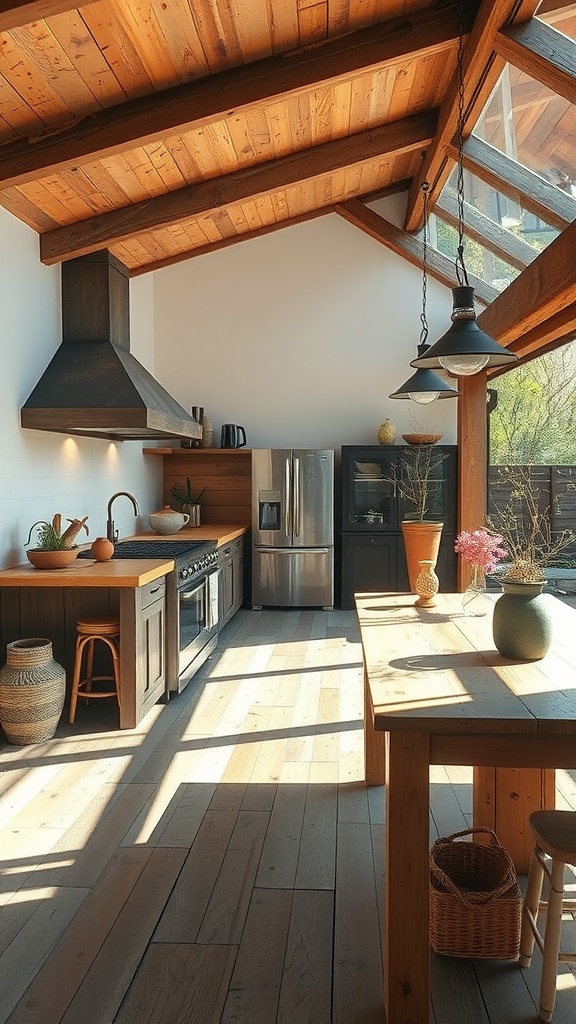
The image showcases a stunning rustic European kitchen that perfectly embodies the idea of seamless indoor-outdoor flow. With its large windows and open design, the space invites natural light and views from outside. This connection is vital for creating a warm and inviting atmosphere.
The use of wooden beams and natural materials throughout the kitchen enhances the rustic theme. The blend of modern appliances with traditional wooden elements makes this a great example of Rustic European Kitchen Design Ideas. The spacious layout encourages movement, making it easy to transition from cooking inside to enjoying a meal outdoors.
This design philosophy not only boosts functionality but also promotes a relaxed lifestyle. Imagine hosting a dinner party where guests can easily mingle between the kitchen and an outdoor patio. Incorporating plants, like those seen in the image, can further create a harmonious balance between indoor and outdoor spaces.
These Rustic European Kitchen Design Ideas showcase how to make a kitchen feel larger and more open. The thoughtful design choices inspire warmth and connectivity, where every meal can feel like an experience shared with nature.
Creative Use of Lanterns for Lighting
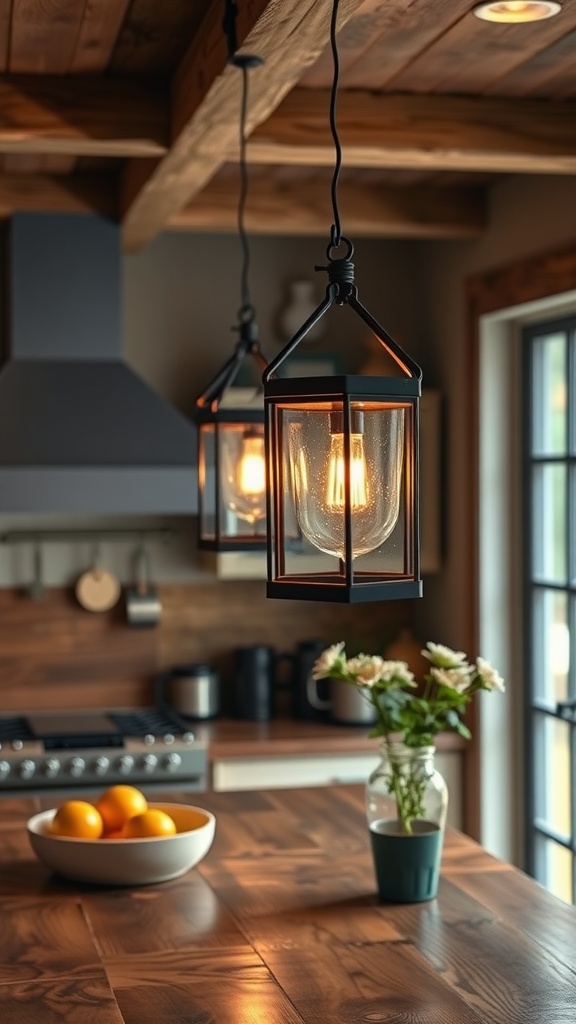
Lanterns can bring a unique charm to rustic European kitchen design ideas. In the image, you see two elegant lanterns hanging from a wooden beam. This choice of lighting adds warmth and character to the space.
They illuminate the kitchen without overwhelming the other elements. The soft glow complements the rich wood tones and creates a cozy setting. Using lanterns in a kitchen is a fantastic way to blend functionality with style, making them perfect for rustic European kitchen design ideas.
These fixtures draw the eye upwards, showcasing the beautiful ceiling beams. They also invite conversation and create a welcoming feel. Pairing lanterns with natural materials further enhances the rustic vibe, making your kitchen a true reflection of European charm.
Consider how the lanterns can interact with the other elements in your kitchen. For instance, a bowl of fresh oranges adds a pop of color against the warm wood tones. This simple touch can elevate the overall design, tying in with rustic European kitchen design ideas.
Vintage Tile Focal Points
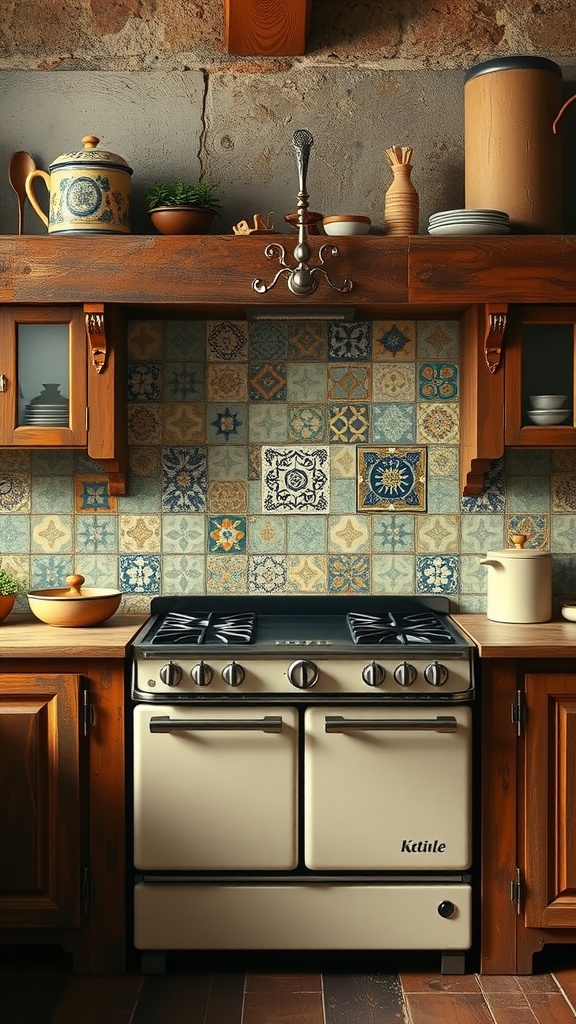
When thinking about rustic European kitchen design ideas, vintage tiles can really make a statement. They add character and intrigue to the space. The image showcases a beautiful tile backsplash featuring a variety of colors and patterns, making it a captivating focal point.
The mix of blue, green, and earthy tones evokes a cozy, homely feel. This kind of design transforms a simple kitchen area into a charming gathering spot. Imagine cooking your favorite meals while surrounded by such an inviting atmosphere.
The vintage tiles work perfectly with the wooden cabinetry and classic stove. This combination really ties together rustic European kitchen design ideas. The warmth of the wood complements the tiles, bringing a sense of history and craftsmanship to the kitchen.
Incorporating vintage tiles into your kitchen design can enhance your cooking experience. They not only serve as a visual delight but can also be a conversation starter during family gatherings. So, if you’re considering rustic European kitchen design ideas, think about adding a vintage tile backsplash.
Accent Walls with Rustic Wallpaper
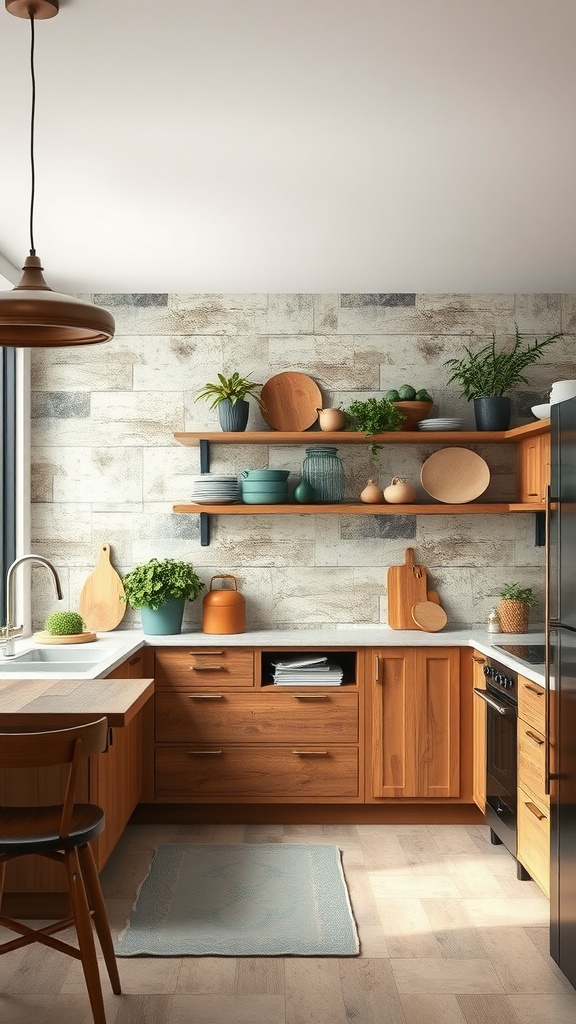
Creating an accent wall with rustic wallpaper can truly transform your space. The image showcases a beautiful kitchen that embodies the essence of Rustic European Kitchen Design Ideas. The textured wallpaper mimics natural materials, bringing warmth and charm to the room.
The choice of colors in the wallpaper complements the wooden elements of the kitchen. This design approach enhances the cozy feel typical of rustic kitchens. The plants and decorative items on the shelves add a personal touch, making the space inviting.
Rustic wallpaper is versatile and can fit various styles within the Rustic European Kitchen Design Ideas. Whether you prefer a more subdued palette or bold patterns, there’s a wallpaper out there that can match your vision. This accent wall becomes a focal point, drawing the eye and creating a sense of depth.
When implementing Rustic European Kitchen Design Ideas, remember that the right wallpaper can blend seamlessly with your cabinetry and countertops. The overall look is casual yet polished, making it perfect for everyday living.
Incorporating rustic wallpaper is not just about aesthetics; it’s also about creating an environment that feels like home. It encourages a relaxed atmosphere where you can enjoy cooking, dining, and spending time with loved ones.
Slate and Stone Countertops
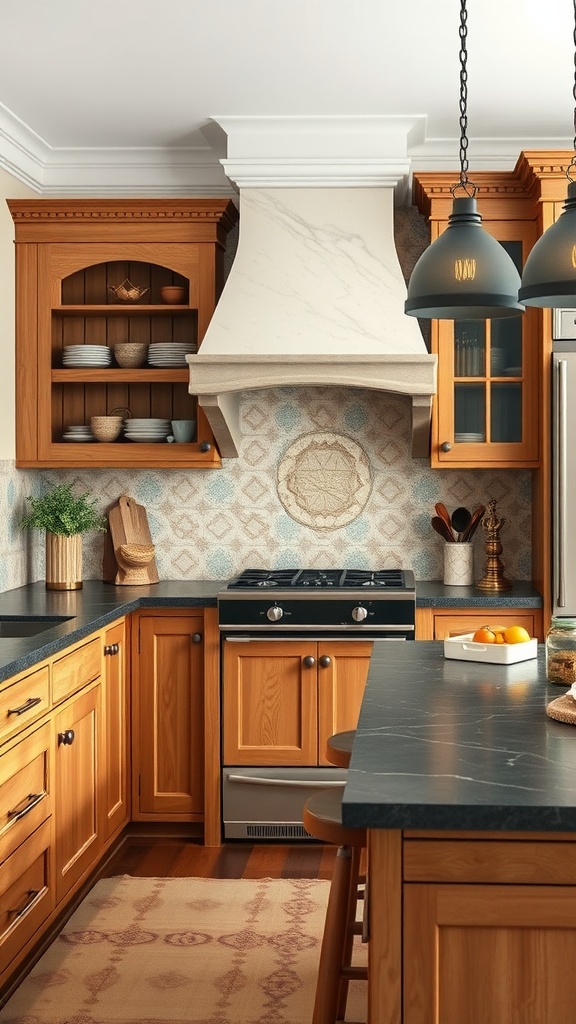
When considering Rustic European Kitchen Design Ideas, slate and stone countertops are a fantastic choice. They bring a touch of nature indoors, adding warmth and character to your space. The image showcases a kitchen featuring rich wood cabinets paired with stunning dark slate countertops. This combination creates a cozy yet sophisticated feel.
Slate is durable and easy to maintain, making it perfect for busy kitchens. It resists scratches and stains, which is a big plus for any home chef. The unique textures and colors found in slate provide a rustic charm that fits perfectly with European kitchen aesthetics.
Stone countertops can vary in color and pattern, allowing you to choose a style that complements your kitchen design. The dark tones in this kitchen contrast beautifully with the lighter wood, creating an inviting atmosphere. If you’re inspired by this look, consider incorporating slate or stone into your own kitchen.
These materials not only enhance the beauty of your kitchen but also offer practical benefits. They are heat resistant, making them ideal for food preparation. Plus, they can easily be paired with other rustic elements, like wooden beams or vintage accents, to create a cohesive design.
In summary, when thinking about Rustic European Kitchen Design Ideas, don’t overlook the beauty and functionality of slate and stone countertops. They can truly elevate your kitchen space.
Cozy Rugs to Enhance Warmth
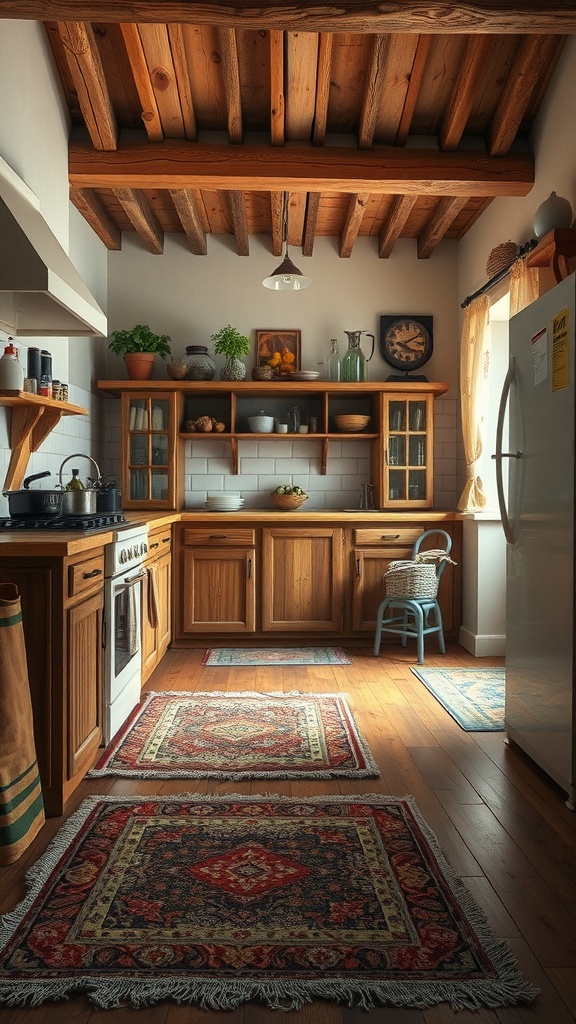
Rugs play a key role in Rustic European Kitchen Design Ideas, adding warmth and comfort to the space. The image showcases a kitchen with rich wooden cabinets and beautiful rugs that instantly draw you in. These rugs not only enhance the aesthetic but also provide a soft landing for your feet, making the kitchen a cozy place to gather.
The intricate patterns on the rugs echo traditional European designs. A mix of colors complements the natural wood tones of the kitchen, creating a harmonious look. Choosing rugs that reflect rustic charm can tie the room together beautifully, making it feel inviting.
Layering different rug sizes is another great idea. In this kitchen, the rugs are placed strategically to guide your movement while adding visual interest. This approach aligns perfectly with Rustic European Kitchen Design Ideas, where functionality meets style.
When selecting rugs, consider materials that withstand wear and tear. Wool or cotton rugs are excellent choices for kitchens due to their durability. Keeping the space clean can be effortless, allowing you to enjoy your cozy kitchen without worry.
Lastly, adding a few personal touches, like a charming basket or potted herbs, can elevate the space even more. These elements, combined with the right rugs, make your kitchen a true reflection of Rustic European Kitchen Design Ideas.
Classic Wooden Bar Stools
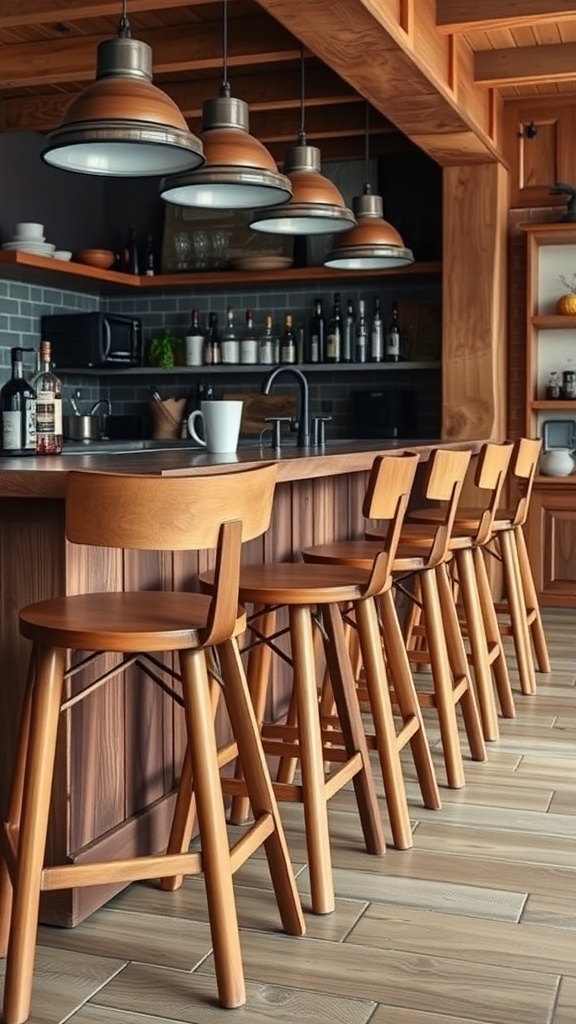
Wooden bar stools are a staple in rustic European kitchen design ideas. Their natural look adds warmth and charm to any space. These stools often feature simple lines and sturdy construction, making them both functional and stylish.
The image showcases a beautiful row of wooden bar stools. Each stool has a clean design that complements the surrounding kitchen. The natural wood finish enhances the rustic feel, making it perfect for a cozy kitchen setting.
Incorporating wooden bar stools in your kitchen can create a welcoming atmosphere. They invite family and friends to gather around for meals or casual chats. Plus, their durability ensures they stand the test of time while fitting seamlessly into rustic European kitchen design ideas.
When selecting bar stools, consider the height and style that works best for your space. Stools that match the kitchen island height will offer comfort. Look for those with comfortable seating and sturdy legs to ensure they are practical.
Overall, classic wooden bar stools are more than just seating; they are an integral part of rustic European kitchen design ideas. They’re perfect for creating a cozy vibe that feels both inviting and timeless.
Fluted Cabinet Doors for Vintage Appeal
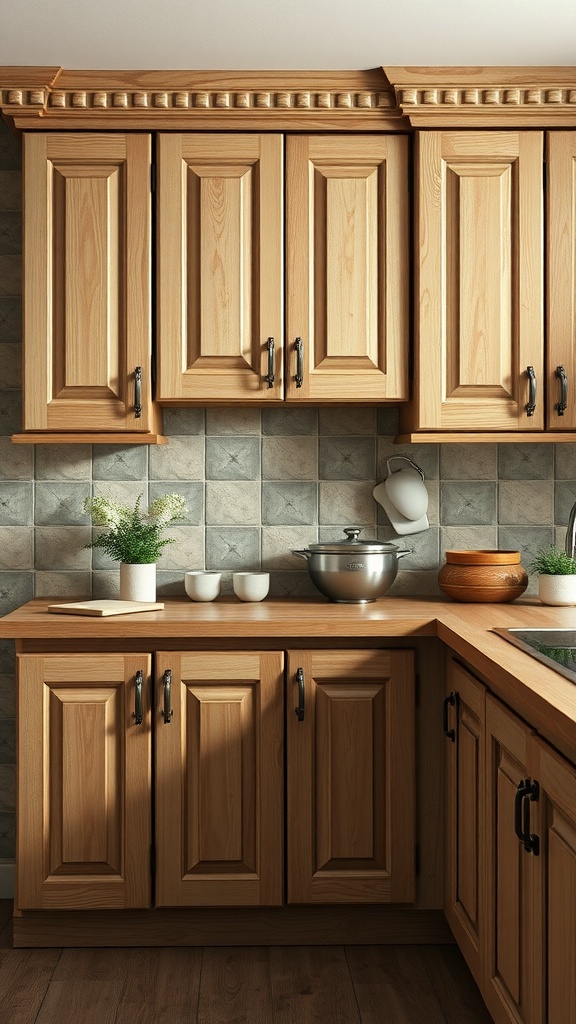
Fluted cabinet doors bring charm to any rustic European kitchen design. This style features vertical grooves that add depth and texture, making cabinets a focal point.
The wood finish highlights the natural grain and warmth, creating a cozy atmosphere. In this image, the smooth, light-colored wood blends beautifully with the tiled backsplash, enhancing the rustic look.
Choosing fluted cabinet doors is a great way to embrace the vintage aesthetic. They not only provide practical storage but also elevate the style of your kitchen.
Rustic European kitchen design ideas often include such cabinetry that balances elegance and simplicity. The combination of natural materials and thoughtful design elements creates spaces that feel inviting and timeless.
Incorporating fluted cabinet doors is an easy way to achieve that classic vibe. Whether you’re renovating or building new, these details can make all the difference.
So if you’re considering rustic European kitchen design ideas, remember to explore the beauty of fluted cabinet doors. They offer a touch of vintage appeal that enhances the overall kitchen aesthetic.
Handcrafted Wooden Serving Boards

Handcrafted wooden serving boards bring a touch of charm to any kitchen. These boards are not just practical; they add to the overall aesthetic of your rustic European kitchen design ideas. Each board tells a story of craftsmanship and careful selection of wood.
In the image, you can see a variety of beautifully designed boards. The rich tones of the wood shine through, showcasing their natural beauty. Some have unique grains and patterns, making them perfect for serving cheese or bread during gatherings.
Incorporating these boards into your kitchen decor can enhance the cozy vibe you strive for in rustic European kitchen design ideas. They can be displayed on shelves or hung on walls as art pieces. Mixing different shapes and sizes adds character to your space.
The blue bowl in the image complements the wooden boards beautifully. It’s a reminder that even simple tableware can elevate the presentation of your favorite snacks. This blend of materials is perfect for creating a warm and inviting atmosphere.
Don’t forget the accessories! A soft cloth alongside the boards can add a splash of color and texture. Such details are key to achieving the rustic feel that defines many European kitchens. These elements work together to create a harmonious space for cooking and entertaining.
Artisan Bread and Cheese Display
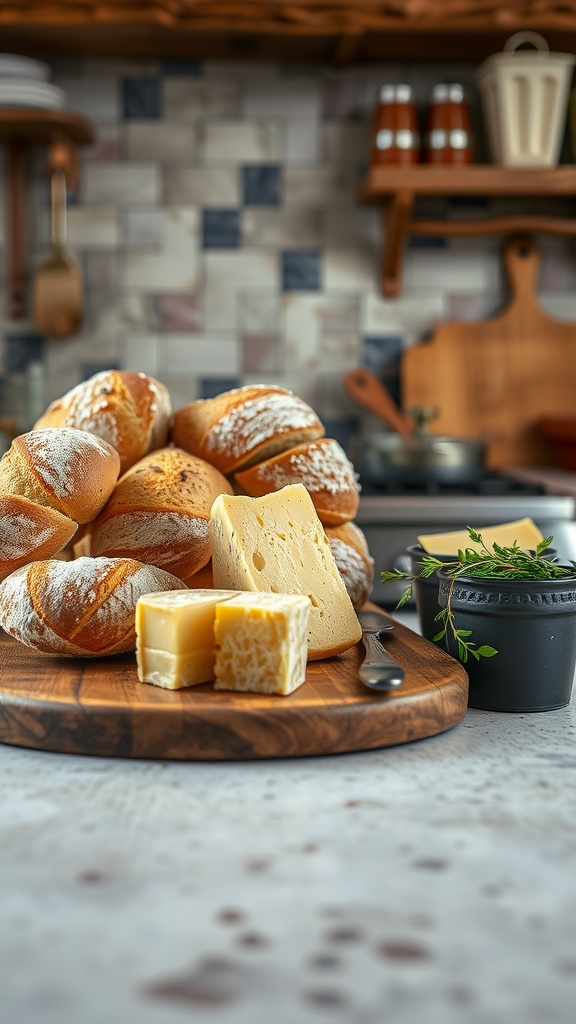
A rustic European kitchen design shines with the charm of an artisan bread and cheese display. Imagine a wooden board filled with freshly baked bread rolls, their golden crusts hinting at the deliciousness within. Paired with an assortment of cheeses, this display creates a warm and inviting centerpiece.
The combination of textures and colors adds a delightful touch to the kitchen. The white dusting on the bread contrasts beautifully with the rich yellows and creamy hues of the cheeses. This arrangement not only looks appealing but also invites casual gatherings over good food. Incorporating these elements into your rustic European kitchen design ideas will create a cozy atmosphere that’s perfect for entertaining.
Consider adding fresh herbs, like thyme or rosemary, for extra flavor and a pop of green. A rustic kitchen isn’t just about the food; it’s about the experience. So, gather your friends, slice some bread, and enjoy the moment. Using simple, natural materials enhances the rustic vibe and connects with the essence of European culinary traditions.
Open Concept Layout for Socializing
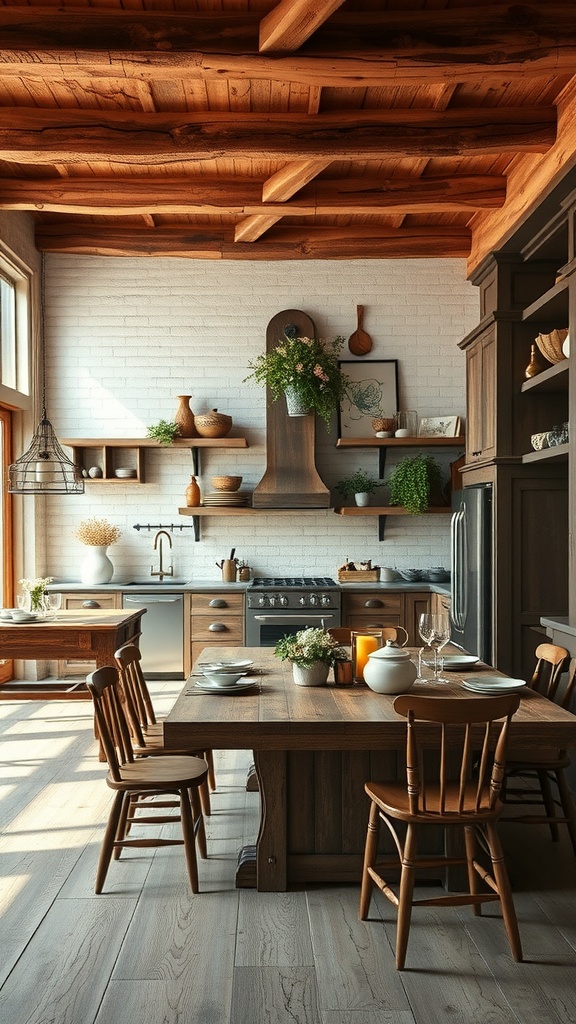
When it comes to Rustic European Kitchen Design Ideas, an open concept layout shines. This style invites everyone to gather, creating a warm and welcoming space. You can see how the kitchen flows seamlessly into the dining area, making it perfect for sharing meals and stories.
The wooden beams and rich textures add charm to the space. Natural light floods in, enhancing the inviting feel. This setup encourages socializing, whether you’re cooking or enjoying a meal. It’s all about connecting with family and friends in a cozy environment.
In this kitchen, the large table takes center stage. It’s where everyone can sit together, share laughs, and enjoy homemade meals. Choosing rustic furniture complements the overall theme, adding character and warmth. These elements work together to create a space that feels both practical and homey.
Rustic European Kitchen Design Ideas often incorporate greenery, which you can spot here. This not only beautifies the kitchen but also brings a touch of nature indoors. Plants can enhance the atmosphere, making it feel fresh and lively.
With this open layout, cooking becomes a communal activity. You can chat with guests while preparing dinner, making cooking feel less like a chore and more like a shared experience. The blend of style and function in this design truly captures the essence of socializing in a cozy kitchen setting.
A Touch of Modern with Rustic Elements

This image showcases a warm, inviting kitchen that blends modern features with rustic charm. The wooden beams and warm tones add a cozy vibe, while the sleek appliances bring a contemporary feel. The combination is perfect for those looking to incorporate Rustic European Kitchen Design Ideas into their homes.
The open shelving displays beautiful dishware, making the kitchen feel personal and lived-in. A mix of bowls and potted plants adds a touch of greenery, enhancing the rustic aesthetic. The large window allows natural light to fill the space, creating an airy atmosphere that’s ideal for cooking or gathering with family.
Elements like the patterned rug and wooden utensils tie the design together, offering a balanced look that feels both stylish and functional. This approach to Rustic European Kitchen Design Ideas emphasizes comfort without sacrificing modern convenience, making it a great option for any home chef.
Whether you’re redesigning your kitchen or just looking for inspiration, this image perfectly illustrates how Rustic European Kitchen Design Ideas can blend the old and the new beautifully. Keep in mind that the key is to find that perfect harmony between rustic and modern elements, ensuring your space feels both cozy and practical.
Rustic Ceiling Fans with Wood Accents
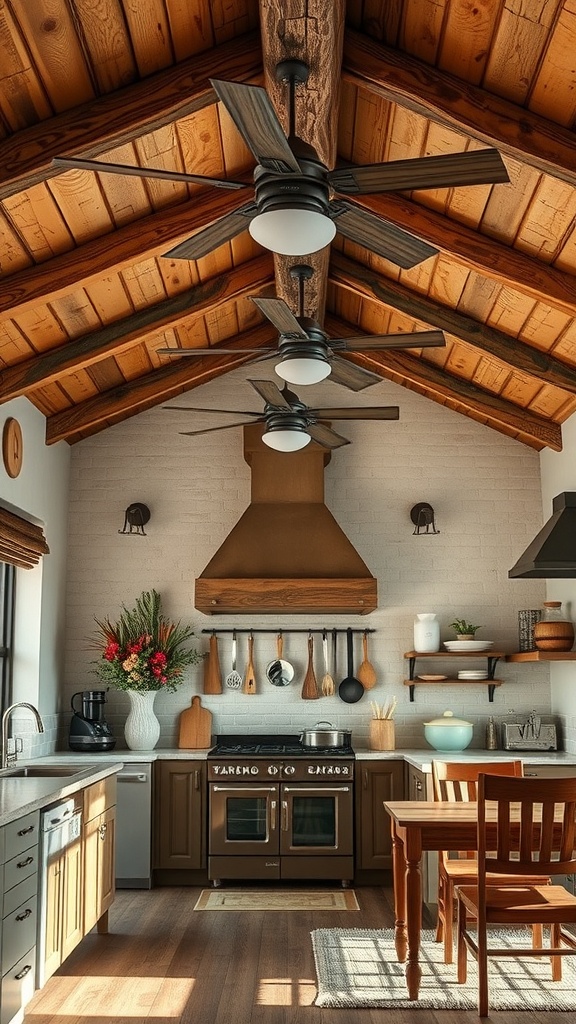
When considering rustic European kitchen design ideas, ceiling fans with wood accents play a key role. They add a charming touch that complements the overall aesthetic of a rustic kitchen.
The image shows a beautiful kitchen with a stunning wooden ceiling. The ceiling fans blend seamlessly with the design, creating a warm and inviting space. These fans not only provide comfort but also enhance the rustic feel of the room.
Wood accents in ceiling fans can tie together various elements in your kitchen. Whether it’s a wooden table or cabinetry, these fans complete the look. In rustic European kitchens, it’s crucial to maintain a cohesive style.
Choosing fans with wooden blades or details can make a significant difference. They can match other wooden features in your kitchen, ensuring a harmonious design. This is all part of the charm of rustic European kitchen design ideas.
Consider how the fan’s color and style work with your existing decor. A fan that echoes the wood tones of your kitchen will enhance its rustic appeal. It’s all about creating a space that feels comfortable and welcoming.
Incorporating ceiling fans with wood accents is a smart and stylish choice. They provide practicality while boosting the rustic vibe. This combination makes them a popular option in rustic European kitchen design ideas.
Ultimately, ceiling fans in these kitchens aren’t just functional—they’re a statement piece. They embody the cozy and inviting atmosphere that defines rustic European kitchen design ideas.
Relaxing Color Schemes Inspired by Nature
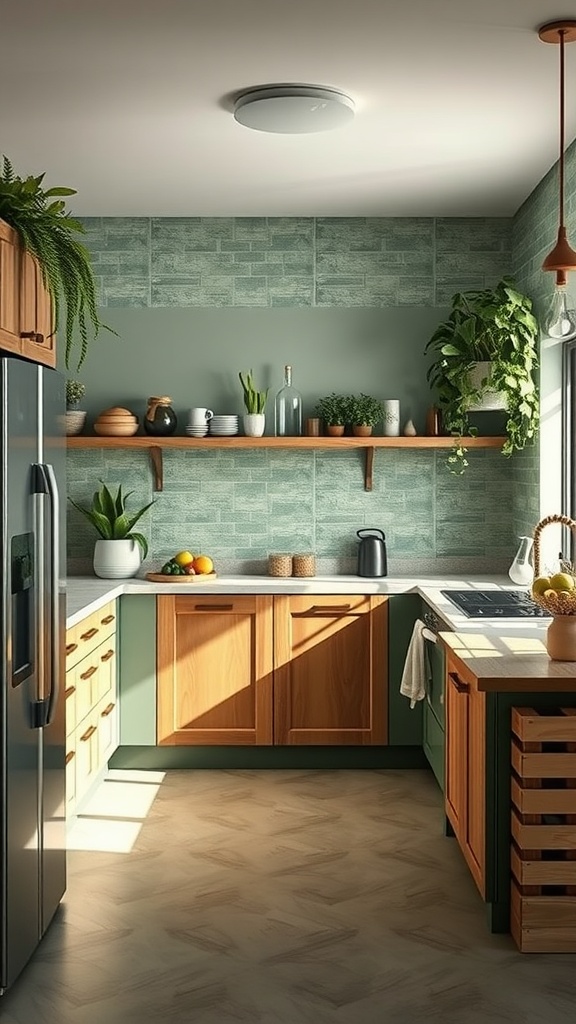
The kitchen in the image showcases a perfect blend of rustic charm and a calming color palette. The shades of green and natural wood create a cozy feel, making it an ideal space for cooking and gathering.
Natural elements are key in this rustic European kitchen design. The green walls echo nature, while the wooden cabinets and open shelves add warmth. This design idea can inspire your own rustic kitchen renovation.
Plants are a vital part of this kitchen’s design. They not only add color but also improve air quality. Incorporating greenery into your space can enhance the rustic European kitchen vibe.
The layout is practical yet inviting. The flow of the kitchen encourages interaction, making it a great spot for family meals. The relaxed color scheme contributes to a tranquil atmosphere, perfect for unwinding after a long day.
When considering rustic European kitchen design ideas, think about combining soft hues with natural materials. This creates a serene environment that feels like a retreat in your own home.
Lighting also plays a role in achieving the right mood. The pendant light in this kitchen adds a modern twist while keeping a rustic touch. A well-lit kitchen can make all the difference.
Choosing a simple, functional design helps maintain the kitchen’s charm. Focus on practicality without sacrificing beauty, which is a hallmark of rustic European style. This kitchen exemplifies how to balance both.
If you’re looking for inspiration, remember that rustic European kitchen design ideas often prioritize comfort and simplicity. The image reflects this beautifully.
Thoughtful Layouts for Efficient Cooking
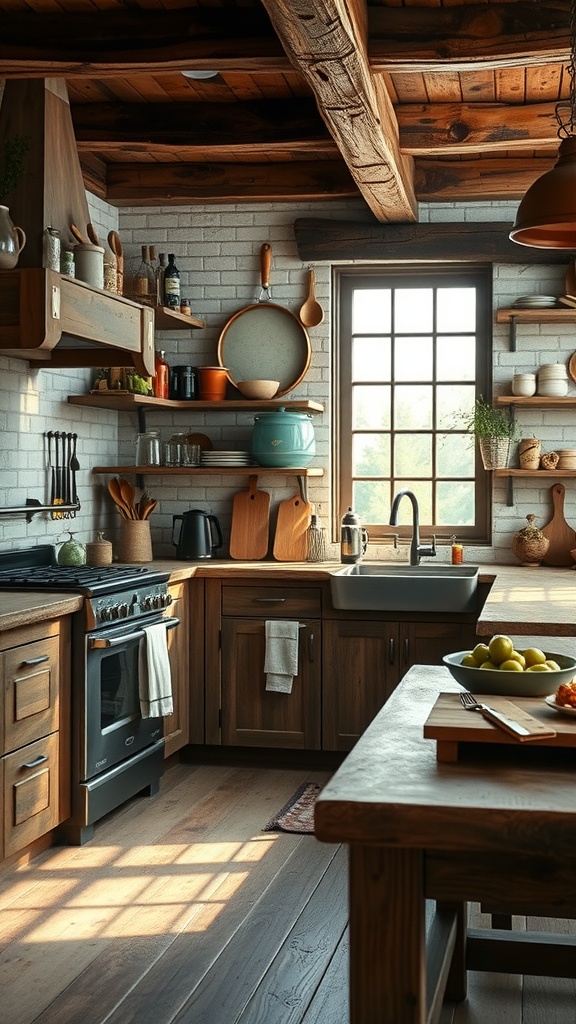
A rustic European kitchen design can truly enhance your cooking experience. The image showcases a cozy kitchen filled with natural wood elements and soft lighting, creating a warm atmosphere. The layout is practical, making it easy to move around while preparing meals. With open shelving and a farmhouse sink, everything you need is within reach.
The use of natural materials like wood and stone gives this kitchen an inviting look. The cabinets are crafted from rich, dark wood, which adds character to the space. It’s a great example of how rustic European kitchen design ideas promote efficiency and comfort.
By keeping essentials organized on shelves, you can maximize space. You won’t have to rummage through drawers to find items! This thoughtful layout encourages creativity while cooking and allows for easy cleanup.
Consider adding similar rustic touches to your kitchen. Incorporate wooden utensils and handmade pottery to enhance the rustic vibe. Remember, a well-planned kitchen layout not only looks good but also supports a seamless cooking flow.
Rustic European kitchen design ideas can be simple yet effective. Use open spaces wisely, integrate your cooking essentials, and enjoy the beauty of a well-designed kitchen. The charm of rustic kitchens lies in their practicality and style, making them perfect for any home.



